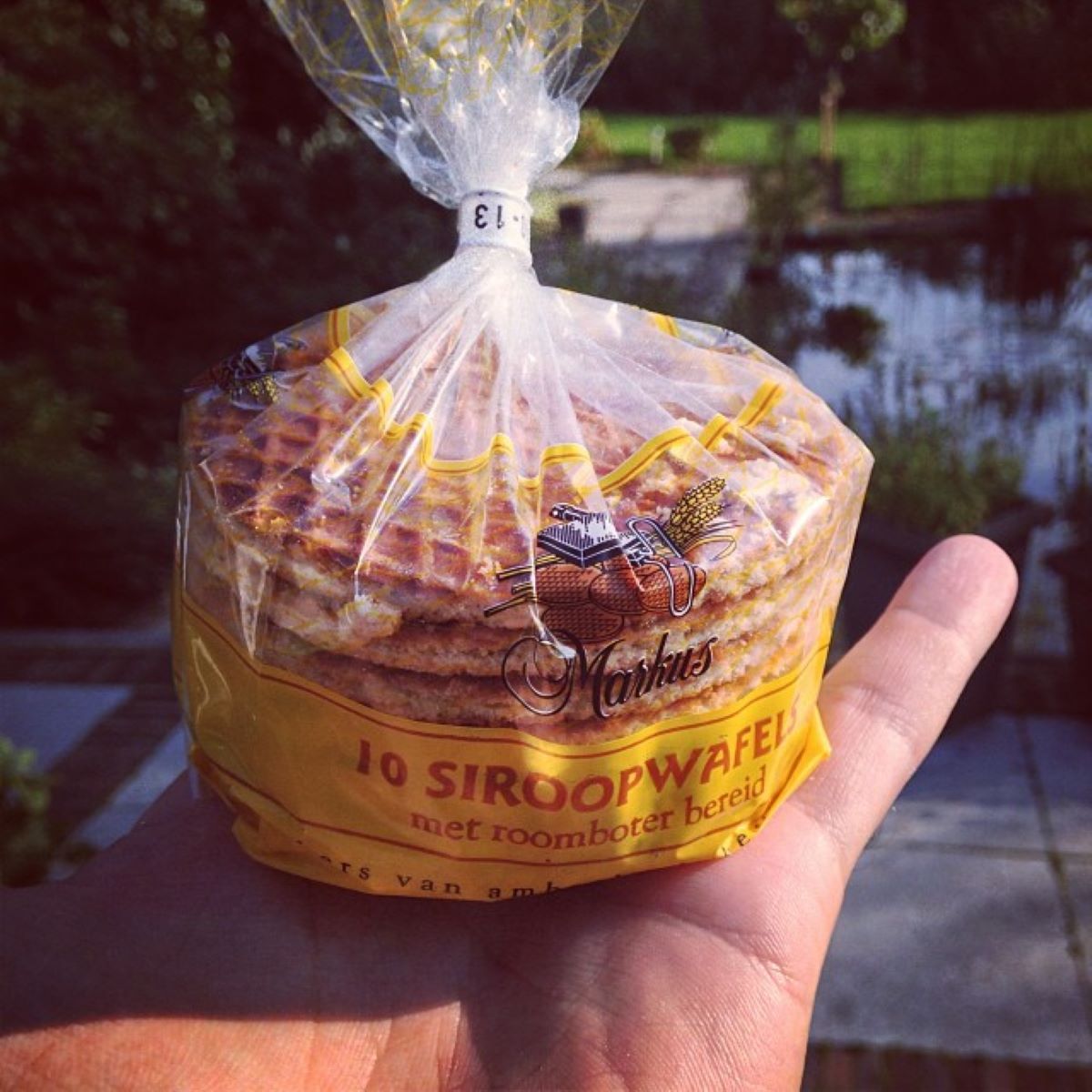Last Updated on November 7, 2025 by Emma Fajcz | Published: January 18, 2024
The stroopwafel perfectly encapsulates a culinary trend that we’ve seen many times before: the transformation of a simple, everyday treat into a highly sought-after culinary delight.
You see it in the histories of typical Tuscan dishes like ribollita, French cassoulet, and even truffles—humble beginnings with a later elevation to haute cuisine.
While this Dutch cookie may not be classified as gourmet, the story of the stroopwafel‘s ascent from a modest treat in a small Dutch town to a beloved and delectable snack enjoyed worldwide is equally fascinating—and mouthwatering.

What are stroopwafels?
The Dutch word “stroopwafel” translates to “syrup waffle.”
These delectable little snacks are absent from any typical breakfast in Amsterdam menu, as they belong to an entirely distinct category of waffle in terms of how they look and how they’d made.
While these thin waffle cookies are still piping hot, the edges are removed with a cutter to make perfectly round discs. Then, they’re carefully sliced in half and a layer of hot caramel syrup is spread on one side. The two halves are put back together, held in place by the syrup, which becomes more solid as it cools.
Stroopwafels are frequently served in the Netherlands atop a steaming mug of tea or coffee, which warms the syrup before you eat it, though they’re not traditionally dunked.

History of stroopwafels
As is the case with many foods, there are some discrepancies over the stroopwafel’s origin story.
Everyone agrees on its birthplace: Gouda, the city in the western part of the Netherlands that also gave the culinary world its famous eponymous cheese. The earliest stroopwafel recipe on record dated in 1840, though the precise date remains a mystery.
Many sources say Gerard Kamphuisen invented the stroopwafel. It’s said he was inspired to find a use for the leftover crumbs and dough scraps in his bakery, which held together (and tasted better) with the addition of syrup. The sweet and cheap treats were a hit with poor locals who couldn’t afford fancy baked goods—early on, they were even called “armenkoeken,” or “poor people’s cookies.”
Stroopwafels grew in popularity beyond Gouda through the 19th century and into the 20th, a demand that eventually required more than 100 stroopwafel bakeries in Gouda to keep up. In the early 20th century, stroopwafel production became mechanized, allowing factories to make more than individual bakeries.
Today, stroopwafels have transcended their origins in Gouda, making waves as a featured flavor in a 2019 McDonald’s McFlurry and earning a place on the United Airlines menu in 2015. You can also easily find them on the shelves of mainstream grocery stores like Walmart and Trader Joe’s in the USA.

Where to try the best stroopwafels in the Netherlands
Stroopwafels are now made globally, and those from your local grocery store may not be authentic Gouda stroopwafels. However, if you visit Gouda, you can get them directly from the source. The factories there often provide tours, and you can buy stroopwafels directly from their bakery storefronts or shops.
Kamphuisen
Rumored to be where the first stroopwafels were made more than two centuries ago. According to the bakery, Kamphuisen’s original (patented) stroopwafel recipe was sealed in an envelope in 1810 and that envelope has still never been opened. The bakery has changed hands over the years, and was fully mechanized in 2018, but they say the recipe remains the same. Kamphuisen is open for tours, which all include a sample stroopwafel.
Berg’s Bakery
Berg’s Bakery is another Gouda institution that has made these sweet treats for a long time. They’re popular enough that, in 1989, the bakery created an offshoot business just for stroopwafels: Van Vliet. You can buy a variety of Van Vliet stroopwafel products in Berg’s Bakery (including waffles filled with chocolate & caramel, stroopwafel liqueur, and stroopwafel truffles), and you can also sign up for a workshop at Van Vliet to make your own stroopwafels!

Markus & Markus bakery
Makers of stroopwafels since the mid-1960s, Markus & Markus bakery boasts locations in Gouda as well as nearby Waddinxveen. Each storefront has what’s known as a “Stroopwafelmuur,” or “stroopwafel wall,” which is basically a giant stroopwafel vending machine on the outside of the bakery. The one in Gouda has 286 compartments full of a vast array of stroopwafel options—including some that are gluten-free or lactose-free.
Punselie Cookie Company
Another iconic spot for these snacks, Punselie Cookie Company became famous for offering an even cheaper version of the stroopwafel, the “stroopkoekjes” (syrup cookies). A slightly modified version is still made in Gouda to this day.

Stroopwafel receipe
Though it may seem daunting, armed with a good recipe and the appropriate waffle iron, you can create delicious stroopwafels at home.
The specialty waffle iron is key. Waffle irons meant to make waffle cones work really well, as do the irons used to make pizzelle cookies, as both produce waffles that are thin enough to mimic a stroopwafel but also thick enough to slice in half for the filling.
For excellent stroopwafel recipes, check out the ones from King Arthur Baking Company or The Spruce Eats. If you lack a waffle iron, The Dutch Table‘s recipe provides an alternative using a griddle and a grill press, with a creative twist using a flower-shaped cookie cutter.

Explore International Cuisine Like a Local
Join one of our top-rated food tours that are offered in many cities throughout the world! With the help of our expert local guides, you’ll get to see, hear, and taste your way through these cities and learn about their fascinating histories and cultures.









